Choosing the Right Dog Ramp by Dog Type
2025 Upgraded Dog Ramp for Bed – Tsukiko 64″ Long, Non-Slip, Adjustable Height 24″–30″, For Small to Large Dogs
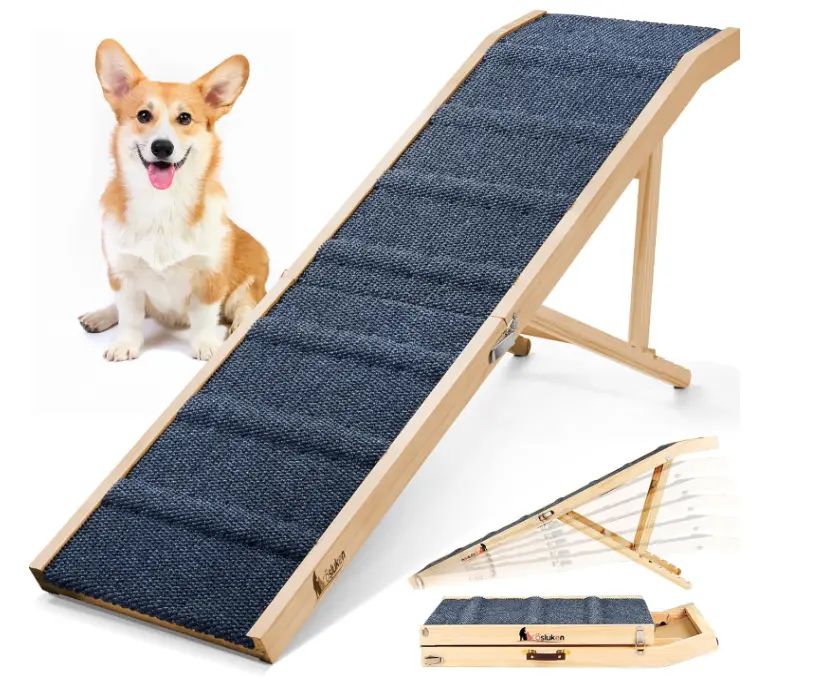
Finding the right dog ramp for high bed setups can be tough—especially when you have a tall bed between 24 to 30 inches. I needed a sturdy and reliable dog ramp for bed 30 inches high that both my small and large dogs could use confidently. After trying a few less stable models, I finally found the Tsukiko 64″ Dog Ramp, and it’s honestly a game-changer.
This large dog ramp for high bed is beautifully crafted from thick wood and folds easily, which makes it perfect for both indoor use and travel. When I searched for the best dog ramp for high bed, durability and adjustability were my top priorities—and this one nails both. With 6 adjustable heights and support for up to 220 lbs, even my heavier dog feels secure walking up to the bed now. The high-traction carpet and non-slip surface with raised strips give added peace of mind, especially for older dogs or those with joint issues.
I’ve tried building a DIY dog ramp for high bed before, but honestly, nothing I made came close to the quality of this. Whether you’re looking for a dog ramp for bed 36 inches high, a dog ramp for 30 inch high bed, or just something reliable and foldable, this one fits all needs. I even tested it as a dog ramp for high beds and car access, and it works perfectly with our SUV. It’s currently ranked as one of the best dog ramps for high beds for good reason.
If you’re on the fence or browsing different options like dog ramps for high beds, stop wasting time. This Tsukiko pet ramp blends convenience, safety, and aesthetics—something you won’t get with every dog ramp for bed high off the ground. You can fold and store it easily, whether under the bed or in your trunk. And with that added landing platform, your pet won’t hesitate before climbing—something missing in many wood dog ramps for high beds I’ve tested.
Bottom line? Whether you want a dog ramp for tall bed, a foldable dog ramp for high bed, or even a best rated dog ramp for high bed with premium traction, this one is built to last and built for all dogs—small, medium, and large.
Stable Dog Ramp for High Beds and Couches – 74” Long, Pine Wood, Non-Slip Carpet
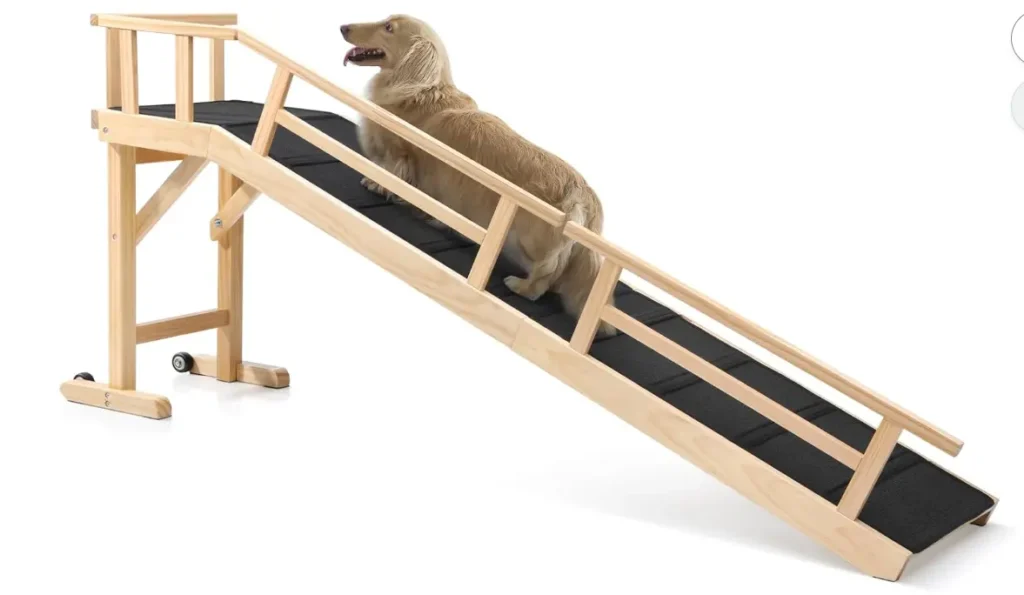
I needed a strong dog ramp for high bed because my old dog can’t jump anymore. I found the Onelike Wooden Dog Ramp, and it’s perfect!
It’s long—74 inches—so it’s not too steep. Even my big dog walks up easily. The ramp has a soft non-slip carpet, so paws don’t slip. It’s safe for small, large, and senior dogs.
There are side rails to stop my dog from falling. You can put the rail on the left or right. At the top, there’s a small platform, so your pet can pause before stepping onto the bed. That makes it feel safe.
This ramp is made from pine wood. It’s strong and smooth. It looks nice in my room too! It can hold heavy dogs—mine is 70 lbs and it works great. It’s much better than a plastic ramp.
I almost made a DIY dog ramp for high bed, but I’m happy I bought this. It’s ready to use and much better quality. If your bed is 25 to 30 inches high, this works great. It also fits sofas and some cars.
Why I Love It:
- Very strong wood ramp
- Soft carpet with grip
- Side rails keep dog safe
- Big dogs and small dogs can use it
- Fits high beds and couches
- Looks nice in my room
- Easy to use – no building needed!
If you want the best dog ramp for high beds, this is the one to get. It keeps your dog safe, helps their joints, and looks great too. I truly recommend it for every pet parent!
For Senior or Arthritic Dogs
I got the Tsukiko Dog Ramp for Bed for my pets, and it works great! If you need a strong and safe dog ramp for high bed, this is the one. It’s perfect for small dogs, large dogs, and even senior dogs who can’t jump anymore.
The ramp is 64 inches long, and it fits high beds from 24 to 30 inches. If you have a dog ramp for bed 30 inches high or a dog ramp for bed 25 inches high, this one will work. It’s also great as a dog ramp for bed 36 inches high if you place it on a small platform.
This is one of the best dog ramps for high beds. It’s made of strong wood, has non-slip carpet, and holds up to 220 pounds. It’s not just for beds—you can use it as a dog ramp for car, sofa, or couch too!
What Makes It Great:
- ✅ Works as a large dog ramp for high bed
- ✅ It’s also a small dog ramp for high bed
- ✅ You can use it for dog ramps for high beds and couches
- ✅ Great adjustable dog ramp for high bed – 6 height settings
- ✅ Use it as a dog ramp for 30 inch high bed or even for a dog ramp for bed 36 inches high
- ✅ Super useful if you ever searched for best dog ramp for high bed or best dog ramps for high beds
- ✅ Not slippery – even a diy dog ramp for high bed can’t beat this grip
If you were ever thinking, “How to build a dog ramp for high bed” or looking for dog ramp for high bed plans, you don’t need to do it yourself. This one is ready to use, easy to fold, and much safer.
It also stores easily. Just fold it and slide it under the bed. It’s perfect for dog ramps for high beds car or SUV trips too.
Whether you searched for:
- adjustable dog ramp for high bed
- dog ramp for bed 25 inches high
- dog ramp for 30 inch high bed
- or even how to build a dog ramp for high bed This ramp is better than most!
PetSafe CozyUp Dog Ramp – A Helpful Step for Pets Who Need It
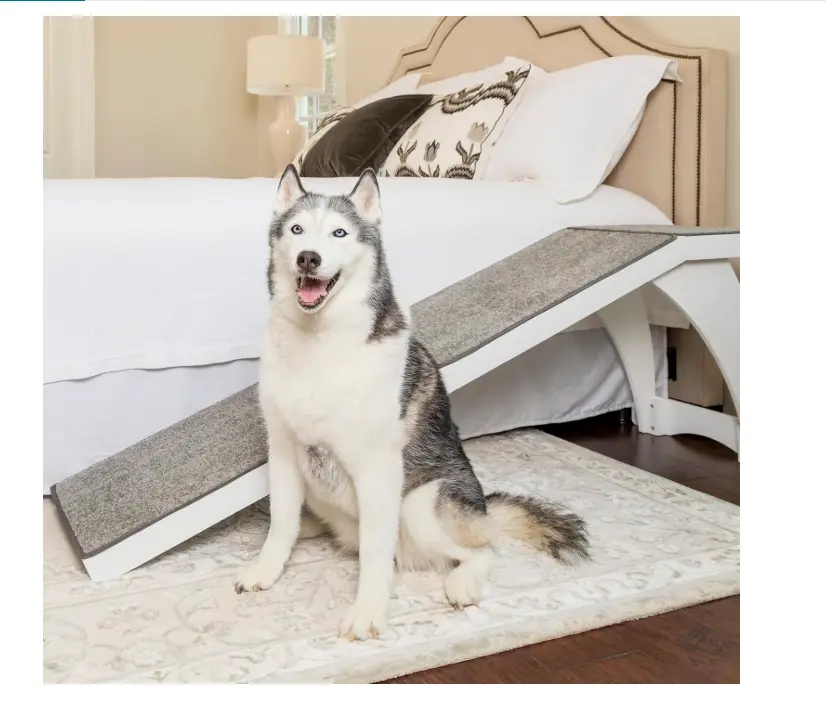
This dog ramp for high bed is a great option for dogs or cats who can’t jump like they used to. It’s long—70 inches—so the incline is gentle. The non-slip carpet makes it safe, and the white wood finish looks clean in the room.
It’s great for large dogs, small dogs, or older pets who need help. The ramp holds up to 120 pounds, so it’s strong. It works well as a large dog ramp for high bed, or even a small dog ramp for high bed.
The ramp fits next to beds and couches. If you’re looking for a dog ramp for bed 30 inches high, this one is close. It’s also useful if you need a dog ramp for bed 36 inches high—you could add a step for the extra height. It helps for more than just beds too. You can use it as a dog ramp for car or sofa. Very useful around the house.
Why It’s One of the Best Dog Ramps
- ✅ Long and strong ramp with a safe slope
- ✅ Works for dog ramps for high beds and couches
- ✅ No slipping—great for senior dogs
- ✅ Matches home furniture
- ✅ No tools needed to build a DIY dog ramp for high bed
- ✅ No need to search for dog ramp for high bed plans or ask how to build a dog ramp for high bed
This is one of the best dog ramps for high beds if you want something ready to use and safe for pets.
Useful for:
- dog ramp for 30 inch high bed
- adjustable dog ramp for high bed (slope is easy even if it’s not adjustable)
- best dog ramp for high bed (top seller, good reviews)
- dog ramps for high beds that don’t look like pet gear
- Replaces the need for DIY dog ramp for high bed
Simple. Strong. Safe. If your dog waits by the bed and doesn’t try to jump anymore, this ramp can help.
Indoor vs. Outdoor Use
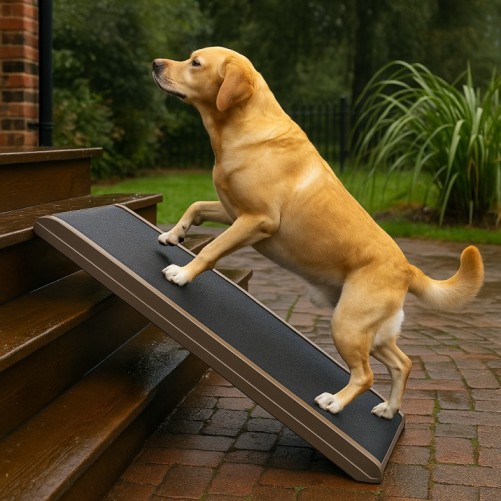
Bedroom or Living Room Ramps
If you’re using a ramp inside, make sure it fits in with your home and isn’t too big or heavy. It should be easy to move but also sturdy.
Tip from Me: I picked a light ramp indoors. It’s easy to move between the bedroom and living room, and I can hide it when I’m not using it.
Look for ramps that are strong, don’t slip, and are easy to put away. Wooden or fabric ramps look nice and work well inside.
Weather-Resistant Outdoor Ramps
If you plan to use the ramp outside, it needs to be weatherproof. Plastic and aluminum ramps work well in rain and shine.
Helpful Tip: I had a wooden ramp outside once, but it got ruined by the rain. Now, I use a ramp that’s built to last outside.
Look for ramps that are waterproof, have UV protection, and have a non-slip surface to keep your dog safe outside.
Multi-Purpose Ramps (Car + Bed + Couch)
Multi-purpose ramps are perfect if you want a ramp that works for both the bed and the car. They’re great if you travel or if your dog loves to get on the couch.
My Personal Experience: The ramp I use works for both the couch and my car. It’s lightweight, foldable, and has a flexible incline, so it fits different places.
Choose a foldable, adjustable, and portable ramp so you can move it between the car, bed, and couch.
Tools and Materials Needed
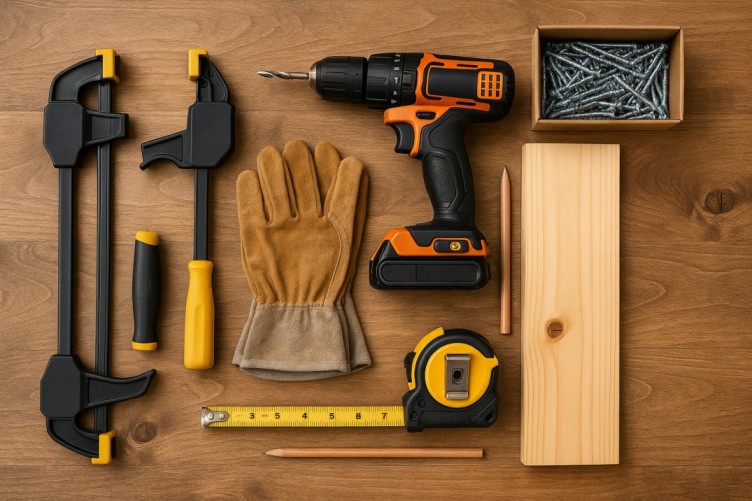
If you’re a little handy (or just like saving money), building your own dog ramp for a high bed can be fun and rewarding. You’ll need a few simple tools—like a saw, drill, screws, and a measuring tape.
For materials, grab a sturdy wood board, some non-slip carpet or grip tape, and support blocks. I once used an old shelf and turned it into a ramp—it worked great!
Step-by-Step Building Guide
- Measure the height from the floor to your bed.
- Cut your board to a length that gives a gentle slope.
- Attach support legs or braces so the ramp stays firm.
- Cover the top with carpet or grip tape so your pup won’t slip.
- Test it yourself! If it holds you (or at least your weight), it’ll hold your dog.
Take your time and make it safe. Your dog’s comfort depends on the ramp’s strength and surface.
Pros and Cons of Building Your Own Ramp
Pros: It’s budget-friendly, fully customizable, and gives you a sense of pride.
Cons: It takes time, tools, and patience. If you’re not careful, the ramp might be wobbly or too steep.
Still, if you’re into DIY, this can be a great weekend project for you and your pup!
Training Your Dog to Use a Ramp
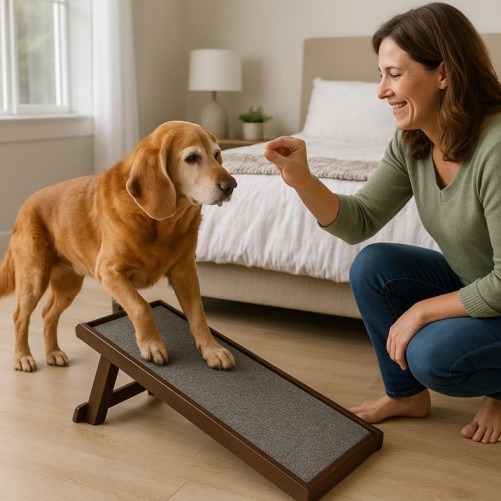
Step-by-Step Ramp Training Techniques
Dogs don’t always love new things right away—especially ramps. Start by placing the ramp flat on the ground. Let your dog walk across it with no pressure.
Once they’re confident, raise it little by little. Use a dog ramp for high bed that stays stable while they learn. Always keep the vibe happy—cheer them on like they just won gold.
Dealing with Fear or Hesitation
If your dog hesitates, don’t force them. Fear takes time to overcome. My dog froze the first time he saw the ramp, so I sat with him and gave him treats for every step forward.
Be patient. Sometimes it takes a few tries, but they’ll get it.
Positive Reinforcement Tips
Use treats, toys, or belly rubs. Reward every step they take. Say “Good job!” even if they only sniff it. Make the ramp feel like a happy place, not a scary one.
In no time, your pup will be zooming up and down like a pro.
Related Post: The Best Material for Your Outdoor Dog Potty Area: A Beginner’s Guide
Maintaining and Cleaning Your Dog Ramp
Best Cleaning Practices by Material
Whether your ramp is wood, plastic, or metal, keeping it clean is easy. For plastic or metal, wipe it down with a damp cloth and mild soap. For wood, avoid too much water—just use a gentle cleaner.
If you’ve got carpet on it, vacuum regularly. I once spilled dog food on mine—lesson learned: wipe it fast before it sticks!
How to Inspect for Wear and Tear
Every few weeks, give your ramp a quick check. Make sure the screws are tight, and the surface isn’t peeling or worn out.
A dog ramp for high bed works best when it’s safe. No one wants a wobbly climb!
When to Replace Your Ramp
If the surface gets too slippery, cracked, or unstable, it’s time to get a new one. Trust your gut—if it doesn’t feel safe, it’s not worth the risk.
Alternative Solutions
Dog Steps and Stairs
Some dogs prefer stairs over ramps. They’re small, stackable, and easy to move. But older dogs with joint pain might struggle with the step-up motion.
Lifting Harnesses and Slings
If your dog is recovering from surgery or can’t move much, a lifting harness gives you control and helps them move safely. I used one after my dog’s surgery—it was a lifesaver.
Pet Lifts or Elevators (for special needs)
Yes, pet elevators exist! If your dog has serious mobility needs and budget isn’t an issue, this is the most high-tech solution. Think of it as a little lift to the bed.
Real-Life Use Cases
Stories from Pet Owners
I’ve heard so many heartwarming stories. One friend’s senior beagle stopped sleeping in bed because he couldn’t jump up. After using a ramp, he was back at his favorite spot by night two.
Before and After Using a Dog Ramp
Before the ramp, my dog limped after every jump. After using the dog ramp for high bed, he’s smoother, happier, and clearly in less pain.
Sometimes, a simple ramp can feel like a miracle.
Impact on Dog’s Health and Mobility
Using a ramp helps prevent injuries and supports aging joints. It’s one small change that makes a big difference. Better sleep, fewer aches, and more freedom—that’s what a ramp gives your furry friend.
Final Thought
If you’re still wondering whether a dog ramp for high bed is worth it—trust me, it is. Whether you build one, buy one, or train your pup to use it, your dog will thank you in tail wags and happy bedtime cuddles.
Want more real-life ramp tips or DIY help? Drop a comment or share your own story—I’d love to hear it!
Common Mistakes to Avoid
Wrong Ramp Size or Angle
One big mistake is choosing the wrong size or angle for your dog ramp for high bed. If the ramp is too steep, your dog will have trouble using it. I learned this the hard way with my first ramp. It was too steep, and my dog kept slipping.
Make sure the ramp has a gentle incline that’s easy for your dog to walk up. This is especially important for senior dogs or breeds with joint problems.
Ignoring the Ramp’s Weight Limit
It’s easy to forget about weight limits. I once bought a ramp for my large dog, but I didn’t check how much it could hold. The ramp didn’t last long.
Always check the weight limit. Find a dog ramp for high bed that’s strong enough for your dog’s size and weight. This keeps your dog safe and ensures the ramp lasts longer.
Not Securing the Ramp Properly
If your ramp isn’t secured, it can slide or wobble. I made this mistake once, and my dog was scared to use the ramp.
Make sure the ramp is securely in place. A dog ramp with rails or a non-slip surface can help keep it steady.
Sustainability & Eco-Friendly Options
Eco-Conscious Materials
When shopping for a dog ramp for high bed, think about the planet. Look for ramps made from eco-friendly materials like bamboo, recycled plastic, or sustainably sourced wood.
I recently switched to a ramp made from recycled plastic. It’s durable, easy to clean, and good for the environment.
Long-Lasting vs. Disposable Options
It’s tempting to buy a cheaper ramp, but they often break quickly. A high-quality ramp will last for years and save you money in the long run.
Invest in a long-lasting dog ramp. It’s worth it!
Green Brands to Consider
Some brands focus on sustainability. PetSafe and Furhaven offer eco-friendly ramps that are both sturdy and safe for your dog.
Costs and Value
Average Price Ranges
Dog ramps cost between $30 and $150, depending on the material, size, and features. The pricier ramps tend to be made from higher-quality materials and offer features like non-slip surfaces and adjustable angles.
What Justifies a Higher Price
More expensive ramps usually have better durability, comfort, and safety features. Orthopedic foam or railings for extra security are common in these ramps. They’re a great choice for larger dogs or those with joint issues.
Where to Find Deals Online
You can find good deals on dog ramps at places like Amazon, Chewy, and Walmart. Keep an eye out for sales, especially during holidays like Black Friday.
Vet and Expert Opinions
What Veterinarians Say About Ramps
Veterinarians often recommend ramps for dogs with arthritis, hip dysplasia, or those that have trouble jumping. My vet says ramps can help reduce strain on your dog’s joints and prevent injuries.
Canine Physical Therapists’ Recommendations
Physical therapists for dogs suggest ramps for pets recovering from surgery or injury. They say that ramps help dogs move safely and comfortably, which speeds up recovery.
Safety Standards to Check
Make sure the ramp has non-slip surfaces and is strong enough for your dog’s weight. Always check the weight limit before you buy.
Buying Tips for First-Time Users
Checklist Before Purchasing
Before buying a dog ramp for high bed, ask yourself:
- Is the ramp the right size for my dog and bed?
- Is it made from durable and safe materials?
- Does it have a non-slip surface?
- What’s the weight limit?
Best Times of the Year to Buy
The best time to buy a ramp is during sales like Black Friday or Cyber Monday. You can also find great deals during end-of-season clearances.
Questions to Ask Before Checkout
- Does the ramp have a return policy?
- Can it be used on other surfaces, like the couch or car?
- Is it easy to clean and store?
Product Comparisons
Dog Ramp vs. Dog Stairs
Dog ramps are easier for older dogs or those with joint pain. They don’t require much effort, unlike dog stairs, which can be hard for senior dogs to climb.
Budget vs. Premium Ramps
Budget ramps are great for light use and small dogs, but premium ramps are better for larger or older dogs. They’re built for durability, comfort, and safety.
Store-Bought vs. DIY
Store-bought ramps are designed for safety and convenience. But if you’re handy, DIY ramps can be a cheap and customizable option. Just make sure it’s sturdy and safe for your dog.
Accessibility and Inclusivity
Ramps for Dogs with Disabilities
Some dog ramps for high bed are designed for dogs with disabilities. They have extra support and a wider surface to accommodate wheelchair-bound dogs.
Inclusive Designs for All Dog Owners
Look for ramps that are easy to use, adjustable, and fit different home setups. This ensures that any dog owner can give their dog the best support.
Final Ramp Recommendations
Choose a ramp that’s comfortable, safe, and fits your dog’s size and health needs.
Your Next Steps as a Responsible Dog Parent
Take your time and ask the right questions before buying. Ensure the ramp is the best choice for your dog’s safety and comfort.
FAQs About Dog Ramps for High Beds
Is it worth investing in a high-end ramp?
Yes—especially for senior, large, or disabled dogs. High-end ramps offer better stability, safety, and comfort.

Pingback: IAMS vs Purina Cat Food (2025): Which One Should You Buy?
Pingback: Top 5 Self-Cleaning Litter Boxes|shetaz automatic litter box